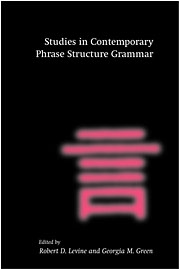Book contents
- Frontmatter
- Contents
- Introduction
- 1 The lexical integrity of Japanese causatives
- 2 A syntax and semantics for purposive adjuncts in HPSG
- 3 On lexicalist treatments of Japanese causatives
- 4 “Modal flip” and partial verb phrase fronting in German
- 5 A lexical comment on a syntactic topic
- 6 Agreement and the syntax–morphology interface in HPSG
- 7 Partial VP and split NP topicalization in German: an HPSG analysis
- Index
Introduction
Published online by Cambridge University Press: 16 December 2009
- Frontmatter
- Contents
- Introduction
- 1 The lexical integrity of Japanese causatives
- 2 A syntax and semantics for purposive adjuncts in HPSG
- 3 On lexicalist treatments of Japanese causatives
- 4 “Modal flip” and partial verb phrase fronting in German
- 5 A lexical comment on a syntactic topic
- 6 Agreement and the syntax–morphology interface in HPSG
- 7 Partial VP and split NP topicalization in German: an HPSG analysis
- Index
Summary
Overview
Head-driven phrase structure grammar (HPSG) has evolved as a synthesis of ideas from a number of theoretical sources, including generalized phrase structure grammar (GPSG), categorial grammar, and formal theories of data structure representation (e.g., the PATR-II formalism and Kasper-Rounds logics of computation). In the course of more than a decade of development these theoretical resources have been applied to a monostratal theory of linguistic structure which is capable of providing a formally explicit grammar for any given natural language. HPSG uses a fundamental theoretical strategy made familiar by GPSG: the enumeration of a class of objects, corresponding to expressions of some natural language, and a set of constraints whose interaction enforces the appropriate covariation of formal properties reflecting the dependencies that any grammar of that language must capture.
A head-driven phrase structure grammar of some language defines the set of signs (form/meaning correspondences) which that language comprises. The formal entities that model signs in HPSG are complex objects called feature structures, whose form is limited by a set of constraints – some universal and some language-parochial. The interaction of these constraints defines the grammatical structure of each such sign and the morphosyntactic dependencies which hold between its subcomponents. Given a specific set of such constraints, and a lexicon providing at least one feature structure description for each word in the language, an infinite number of signs is recursively characterized.
- Type
- Chapter
- Information
- Studies in Contemporary Phrase Structure Grammar , pp. 1 - 38Publisher: Cambridge University PressPrint publication year: 2000
- 5
- Cited by



